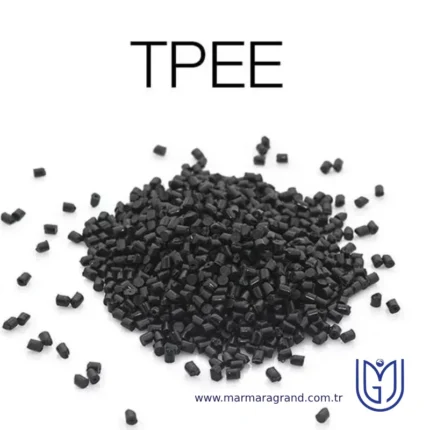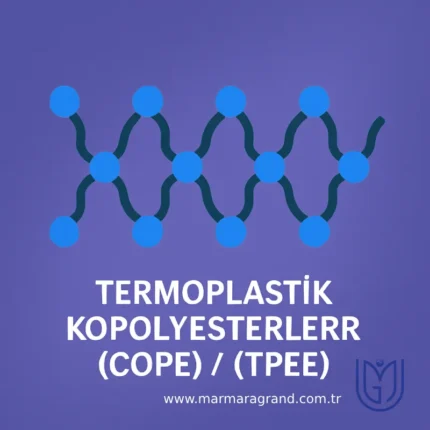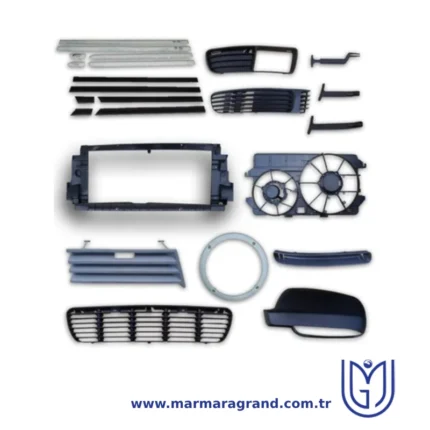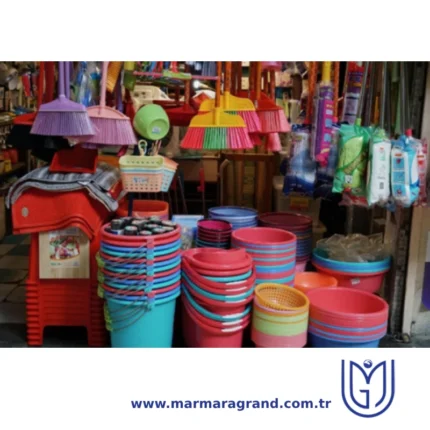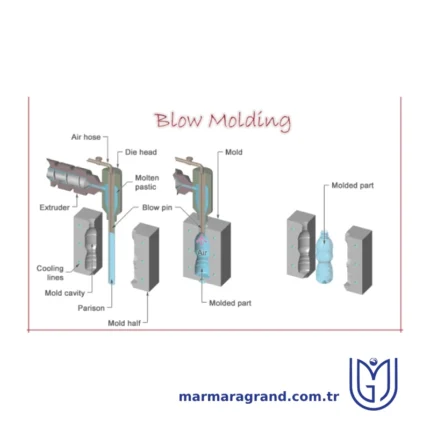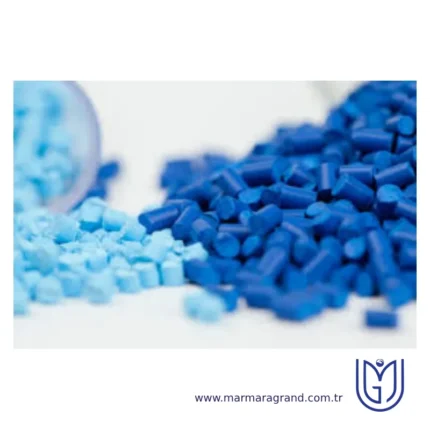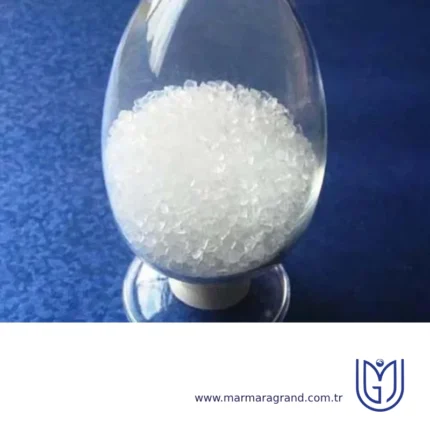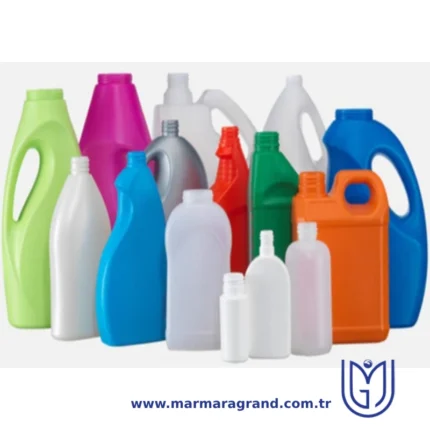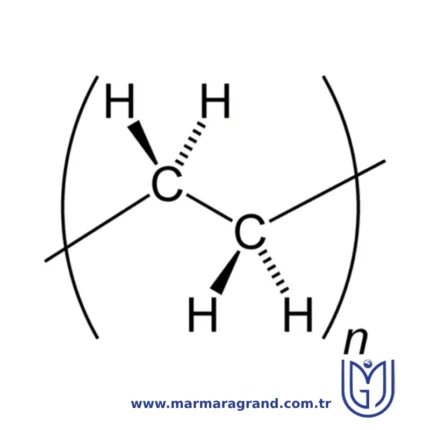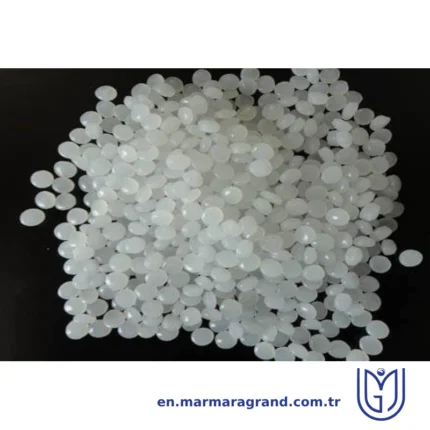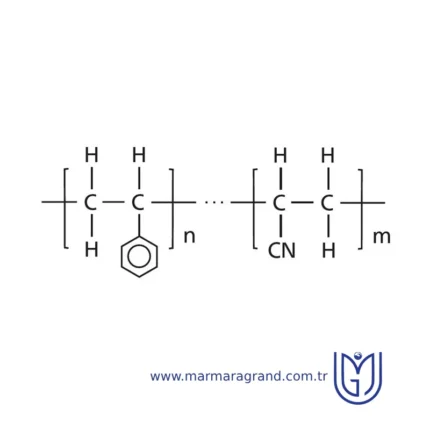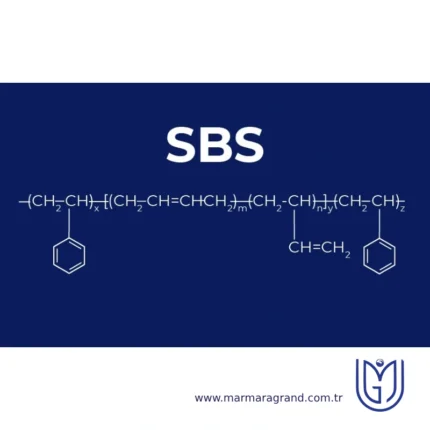(COPE)/(TPEE) Thermoplastic copolyesters
Thermoplastic Copolyesters (COPE), also known as Thermoplastic Polyester Elastomers (TPEE), are a class of thermoplastic elastomers (TPEs) that combine the mechanical properties of engineering plastics with the elasticity of rubber. They are composed of hard polyester crystalline segments and soft amorphous segments, providing a balance of strength, flexibility, and chemical resistance.
PropertiesThermoplastic Copolyesters (COPE), also known as Thermoplastic Polyester Elastomers (TPEE), combine the mechanical strength of engineering plastics with the flexibility and resilience of elastomers. They exhibit excellent elasticity, allowing them to return to their original shape after deformation, while also providing high tensile strength and durability. COPE materials offer outstanding chemical and solvent resistance, making them suitable for harsh environments. Their thermal stability enables them to maintain performance across a wide temperature range, with good low-temperature flexibility and resistance to heat aging. Additionally, they possess excellent abrasion resistance, impact strength, and fatigue resistance, ensuring longevity in demanding applications. With easy processability through injection molding, extrusion, and blow molding, COPE is widely used in automotive, industrial, consumer, and medical applications where a balance of toughness, flexibility, and chemical resistance is required.
StructureThermoplastic Copolyesters (COPE), also known as Thermoplastic Polyester Elastomers (TPEE), are a class of high-performance elastomers that combine the characteristics of both thermoplastics and rubbers. Their structure consists of alternating soft and hard segments, where the soft segments are typically made of aliphatic polyether or polyester, providing flexibility and elasticity, while the hard segments are composed of polyester blocks, offering strength, thermal resistance, and durability. This segmented block copolymer structure enables TPEEs to exhibit excellent mechanical properties, such as high tensile strength, impact resistance, and superior fatigue endurance. The presence of ester linkages in the hard phase contributes to chemical resistance and heat stability, while the soft phase ensures flexibility even at low temperatures. Due to this unique molecular architecture, COPEs find applications in various industries, including automotive, consumer goods, electrical components, and medical devices, where both resilience and processability are essential.
Applications
- Automotive: Used in air ducts, CVJ boots, bellows, gaskets, and wire coatings due to high heat and chemical resistance.
- Industrial & Mechanical: Employed in conveyor belts, hoses, seals, and grommets for durability and flexibility.
- Consumer Goods: Found in footwear soles, sports equipment, and flexible smartphone components for comfort and toughness.
- Electrical & Electronics: Used in cable insulation, connectors, and protective coatings due to excellent dielectric properties.
- Medical Devices: Applied in tubing, catheters, and soft-touch grips because of biocompatibility and sterilization resistance.
Advantages
- High Elasticity & Flexibility: Maintains shape and flexibility even under stress.
- Excellent Heat Resistance: Performs well at elevated temperatures compared to other TPEs.
- Superior Mechanical Strength: Offers high tensile strength, impact resistance, and fatigue endurance.
- Good Chemical Resistance: Resistant to oils, solvents, and many industrial chemicals.
- Wide Processing Window: Easily processed through injection molding, extrusion, and blow molding.
- Recyclable: More environmentally friendly than thermoset elastomers.
Disadvantages
- Higher Cost: More expensive than other thermoplastic elastomers (TPEs).
- Limited Low-Temperature Flexibility: Can become less flexible at extremely low temperatures compared to TPU.
- Absorbs Moisture: May require drying before processing to prevent defects.
- Processing Challenges: Requires precise temperature control during molding and extrusion
Acrylonitrile Butadiene Styrene (ABS)
ABS is a terpolymer made by polymerizing styrene and acrylonitrile in the presence of polybutadiene. The proportions can vary from 15% to 35% acrylonitrile, 5% to 30% butadiene and 40% to 60% styrene. ABS is most commonly polymerised through the emulsification process or the expert art of combining multiple products that don’t typically combine into a single product.
Structure
ABS is a long chain of polybutadiene crisscrossed with shorter chains of poly(styrene-co-acrylonitrile).Properties
The combination of polymers gives ABS a unique set of properties that make it highly desirable for various applications. The acrylonitrile component contributes to the material's chemical and thermal resistance, while the butadiene component enhances its impact strength and toughness. Lastly, the styrene component imparts rigidity and processability to the ABS material. ABS tensile strength ranges from 30 to 60 megapascals (MPa), ensuring structural integrity and load-bearing capabilities. also ABS materials demonstrate good resistance to a wide range of chemicals, including acids, alkalis, and various solvents.Applications
Automotive Industry ABS is extensively used in the automotive industry for both interior and exterior components. Its excellent impact resistance, durability, and ease of processing make it suitable for applications such as dashboard panels, door trims, interior handles, and exterior body parts. 2.Consumer Goods: It is commonly used for manufacturing household appliances, including vacuum cleaners, kitchen appliances, and home entertainment systems. ABS's toughness, impact resistance, and electrical insulation properties make it suitable for these applications. 3.Medical and Healthcare: ABS materials are increasingly used in the medical and healthcare sectors. Their biocompatibility, ease of sterilization, and resistance to chemicals make them suitable for applications such as medical equipment housings, handles, and trays. ABS's dimensional stability and durability ensure that medical devices withstand repeated sterilization processes without compromising their performance. 3.Industrial and Manufacturing: ABS materials find numerous applications in the industrial and manufacturing sectors. They are commonly used in the production of protective equipment, tool handles, machinery components, and housings for industrial machinery. ABS's excellent mechanical properties, including impact resistance and dimensional stability, make it suitable for demanding industrial environments.Advantages
- reasonable production costs
- ability to withstand being heated and cooled multiple times
- suitable for recycling
- high Impact resistance
- Chemical resistance
- High Strength and stiffness
Disadvantages
- Flammability
- Poor weather resistance
- Limited heat resistance
Blow Molding
Blow molding is a manufacturing process used to create hollow plastic parts by inflating a heated plastic tube (called a parison or preform) inside a mold cavity until it conforms to the shape of the mold. It is widely used for producing bottles, containers, and other hollow objects.
Types of blow moldingContinuous Extrusion Blow Molding (EBM) Process:
- Molten plastic is continuously extruded in a tube-like form (parison).
- A mold clamps around the parison and inflates it with air.
- The part cools and solidifies before being ejected.
- Reciprocating Screw System: The screw moves back and forth to accumulate plastic before pushing it into the mold.
- Accumulator Head System: Plastic is stored in an accumulator before being discharged in a single shot.
- Plastic is first injection molded into a preform (small tube-like shape with a finished neck).
- The preform is then transferred to a blow mold and inflated.
- The final shape is formed, cooled, and ejected.
- Similar to IBM, but includes a stretching step before inflation to improve strength and clarity.
- The preform is reheated, stretched lengthwise, and then blown into shape.
- A parison is extruded and clamped in a mold.
- The parison is stretched both axially (lengthwise) and radially (outward) before being inflated.
Advantages of blow molding
- Cost-Effective Production
- High Efficiency & Fast Production
- Ability to Produce Complex Shapes
- Lightweight and Durable Products
- Versatile Material Usage
- Suitable for Large & Small Products
Disadvantages of blow molding
- Limited to Hollow Shapes
- High Initial Equipment & Mold Costs
- Inconsistent Wall Thickness
- Weak Seams & Stress Points
- Less Precision Compared to Injection Molding
- High Energy Consumption
Applications of blow molding
- packaging Industry: Bottles for beverages, cosmetics, pharmaceuticals, and household products.
- Automotive Industry: Fuel tanks, air ducts, washer fluid reservoirs, and coolant tanks.
- Industrial & Chemical Storage: Drums, barrels, IBCs, and spray bottles.
- Medical & Pharmaceutical: IV bottles, medicine containers, and diagnostic device housings.
- Consumer Goods: Toys, furniture components, water bottles, and detergent containers.
- Construction Industry: Water tanks, septic tanks, pipes, and conduits.
- Agriculture Industry: Pesticide and fertilizer containers, watering cans, and irrigation components.
Ethylene TetraFluoroEthylene (ETFE)
Ethylene Tetrafluoroethylene (ETFE) is a high-performance fluoropolymer known for its exceptional strength, lightweight nature, and resistance to environmental conditions. It was originally developed as an insulating material for the aerospace industry but is now widely used in architectural and industrial applications.
Structure
Ethylene Tetrafluoroethylene (ETFE) is a copolymer composed of ethylene (C₂H₄) and tetrafluoroethylene (C₂F₄) units. Its molecular structure consists of a repeating chain of carbon atoms bonded to both fluorine and hydrogen atoms, giving it a unique combination of chemical resistance, mechanical strength, and thermal stability. The presence of fluorine atoms enhances its non-stick properties and high resistance to UV radiation, while the ethylene component contributes to its flexibility and toughness. Unlike polytetrafluoroethylene (PTFE), ETFE has a lower fluorine content, making it slightly less chemically inert but significantly stronger and more impact-resistant. This structural composition results in a lightweight, durable material that retains its transparency and mechanical properties even under extreme environmental conditions. ETFE's semi-crystalline structure also allows it to be processed into thin films, making it highly suitable for architectural applications, insulation, and protective coatings.Properties
Ethylene Tetrafluoroethylene (ETFE) possesses a unique combination of properties that make it highly versatile across various applications. It is exceptionally lightweight, weighing only about 1% of the weight of glass, while maintaining high tensile strength and impact resistance. Its chemical structure provides outstanding resistance to ultraviolet (UV) radiation, weathering, and most chemicals, ensuring long-term durability in harsh environments. ETFE is highly transparent, allowing up to 95% of natural light to pass through, making it an excellent choice for architectural applications. Additionally, it has a low coefficient of friction, giving it self-cleaning and anti-fouling properties. The material is also highly flexible, capable of stretching up to three times its original length without losing integrity. With a high melting point of around 265°C (509°F), ETFE exhibits excellent thermal stability and can withstand extreme temperature fluctuations without degradation. Furthermore, it is a recyclable material, adding to its sustainability by reducing environmental impact. These combined properties make ETFE a preferred choice for applications in construction, aerospace, medical, and renewable energy industries.Advantages
• Lightweight: Weighs only about 1% of the weight of glass. • High Strength & Durability: Resistant to mechanical stress, impact, and punctures. • Transparency: Allows up to 95% natural light transmission. • UV & Weather Resistance: Does not degrade under prolonged sunlight exposure. • Chemical Resistance: Withstands most acids, solvents, and other harsh chemicals. • Self-Cleaning Surface: Low friction and non-stick properties prevent dirt accumulation. • Thermal Stability: Can withstand extreme temperatures (-185°C to 150°C). • Flexibility & Elasticity: Can stretch up to three times its length without damage. • Eco-Friendly & Recyclable: Can be melted down and reused.Disadvantages
• Higher Cost: More expensive than traditional materials like glass or polycarbonate. • Flammability Concerns: Can burn under extreme conditions but is self-extinguishing. • Limited Structural Support: Needs additional framing or inflation systems for strength. • Softness & Scratch Sensitivity: Can be scratched more easily than glass. • Noise Insulation: Provides less soundproofing compared to solid materials.Applications
• Architecture & Construction: Used in stadiums, skylights, and domes (e.g., Allianz Arena, Eden Project). • Aerospace & Automotive: Used for wire insulation and protective coatings. • Medical Industry: Used for tubing, catheters, and biocompatible coatings. • Chemical Industry: Lining for pipes and tanks due to its chemical resistance. • Solar & Renewable Energy: Used in photovoltaic panel coatings and greenhouse covers. • Electronics: Used in high-performance cable insulation for aerospace and telecommunications.High Density PolyEthylene Film (HDPE)
High Density Polyethylene (HDPE for short) is a thermoplastic polymer derived from petroleum with a generalized chemical formula (C2H4)n. The HDPE formula represents the repeating monomer unit of ethylene and forms a poly-ethylene molecular chain. HDPE is distinct from other forms of polyethylene in that its side chain branching frequency is lower than other polyethylene types, where HDPE is commonly referred to as a “linear” chain. This linear structure allows HDPE to pack together more tightly and is the reason for its impressive material characteristics.
Properties
- High Strength-to-Density Ratio: While lightweight, HDPE exhibits excellent tensile strength, making it suitable for heavy-duty applications.
- Chemical Resistance: It is resistant to a wide range of chemicals, acids, and bases, ensuring durability in corrosive environments.
- Low Moisture Absorption: HDPE’s low water absorption ensures its effectiveness in moisture-prone applications.
- Flexibility and Impact Resistance: It withstands impact and environmental stress, even under extreme conditions.
- Thermal Resistance: HDPE maintains integrity in a broad temperature range, making it ideal for outdoor and industrial uses.
STRUCTURE
The structure of High-Density Polyethylene (HDPE) is characterized by long, linear chains of repeating ethylene units (–CH₂–CH₂–) with minimal or negligible branching. This linear configuration allows the polymer chains to pack closely together, resulting in a high degree of crystallinity (up to 80-90%) and a dense molecular arrangement. The compact structure enhances intermolecular van der Waals forces, giving HDPE its high tensile strength, rigidity, and chemical resistance. The lack of branching, achieved through polymerization methods like Ziegler-Natta or metallocene catalysis, is a defining feature that differentiates HDPE from other polyethylene types, such as Low-Density Polyethylene (LDPE). This tightly packed and highly organized structure makes HDPE a robust and durable material, widely used in industrial and consumer applications.Applications
HDPE plastic is used in a laundry list of applications, as it is currently one of the most versatile plastic materials worldwide. Its strength, impact and corrosion resistance, chemical profile, and other valuable characteristics make it an ideal product material for various industries. Below is a brief list of some of the many uses of HDPE plastic:- Corrosion-resistant piping, HDPE sheet, and stock material
- Fuel tanks
- Food and beverage containers, plastic bottles, milk jugs, cups, etc.
- Shampoo/conditioner bottles, ointment tubes, personal care product containers, etc.
- Trash cans, recycle bins, plastic containers, etc.
- Bread bags, cereal box liners, food storage containers, etc.
- Laundry detergent bottles
- Recycled plastic lumber and composites
- Medical equipment
- 3D printing filament
- Boating components
- Coax cable insulators
- Sewage mains
- Pyrotechnic components
Advantages
- High strength-to-weight ratio
- Low friction coefficient and low moisture absorption
- High impact strength, resistant to dents and scratches
- Mold, mildew, rotting, mineral acids/bases, soil, and weather-resistant
- Resistant to chemicals, water, solvents, acids, detergents, and cleaning fluids
- Very malleable when heated and experiences medium to low shrinkage
- Easily recycled
- Can be sterilized via boiling, does not harbor bacteria well, and is dishwasher safe
- Replaces heavier materials in some applications
- Cost-effective
Disadvantages
- In certain forms, it can be flammable as it is a petroleum-based product
- Exhibits high thermal expansion
- Weak to oxidizers and chlorinated hydrocarbons
- Difficult to bond
- Sensitive to stress-cracking in suboptimal environments
Low Density PolyEthylene (LDPE)
LDPE film grade is divided into several types, including general-purpose film, high-transparency film, heavy-duty film, shrink film, and cast film. These materials possess superior physical and mechanical properties, along with high chemical stability and excellent electrical insulation. They also feature low water vapor permeability and outstanding processability, making them ideal for various applications. Films made from these resins provide exceptional clarity and strong resistance to aging, ensuring durability and long-lasting performance.
StructureLDPE (Low-Density Polyethylene) film grade is a thermoplastic polymer made from ethylene monomers (C₂H₄) through a high-pressure polymerization process. Its molecular structure is characterized by high branching, which gives it its unique properties. Key Structural Features: Highly Branched Polymer:
- LDPE has short-chain and long-chain branches, preventing tight packing of polymer chains.
- Due to branching, LDPE has low crystallinity (~40–50%), making it soft and transparent.
- It is more flexible and stretchable than HDPE (High-Density Polyethylene).
- LDPE has a broad molecular weight distribution, contributing to good melt strength and processability in film extrusion.
PropertiesLow-Density Polyethylene (LDPE) film grade is a highly flexible and lightweight material known for its excellent elongation, impact resistance, and transparency. With a density ranging from 0.915 to 0.930 g/cm³, it offers good clarity but can appear slightly hazy. It has a relatively low melting point of around 105–115°C and remains flexible even at sub-zero temperatures, making it suitable for various applications. LDPE exhibits moderate tensile strength (8–17 MPa) and exceptional elongation at break (100–600%), ensuring durability and resilience. While it provides a good moisture barrier, its gas barrier properties are poor, allowing oxygen and CO₂ to pass through. Chemically, LDPE resists acids, bases, and alcohols but is vulnerable to hydrocarbons. Its excellent heat-sealing properties make it ideal for packaging applications, including food wrap, shrink films, and shopping bags. Additionally, it is widely used in agricultural films, protective industrial films, and medical applications such as IV bags and tubing. LDPE is typically processed through blown or cast film extrusion, operating within a temperature range of 160–220°C. However, due to its susceptibility to UV degradation, stabilizers are often added for outdoor applications. Overall, LDPE film grade is a versatile and cost-effective material, valued for its flexibility, sealability, and ease of processing.
Applications
- Packaging
- Used for manufacturing flexible packaging films (e.g., shopping bags, wraps, and pouches).
- Food packaging, including wraps, freezer bags, and shrink films.
- Industrial packaging for wrapping materials, products, and protective covers.
- Agricultural Use
- Greenhouse films for agricultural purposes, creating protective environments for plants.
- Mulch films for soil coverage and weed control.
- Consumer Products
- Plastic bags for grocery stores, retail packaging, and garbage bags.
- Cling films for food preservation and covering items.
- Disposable liners for various containers.
- Construction
- Vapor barriers in buildings, preventing moisture from seeping into structures.
- Covers for construction materials during storage or transportation.
- Medical Use
- Sterile packaging for medical devices, equipment, and pharmaceuticals.
- Medical drapes and covers.
Advantages
- Flexibility
- LDPE film is highly flexible and can be stretched without breaking.
- Transparency
- Offers high clarity and transparency, making it ideal for packaging.
- Chemical Resistance
- Good resistance to chemicals, oils, and greases.
- Low Cost
- Relatively affordable material, making it a cost-effective solution for many applications.
- Ease of Processing
- Easy to process with methods like extrusion, injection molding, and blow molding.
- Lightweight
- Lightweight material, reducing transportation and handling costs.
- Moisture Resistance
- Water-resistant properties, providing good moisture protection in packaging.
Disadvantages
- Low Strength
- Low tensile strength and can tear easily under stress or load.
- Limited Heat Resistance
- Has a low melting point, which limits its use in high-temperature environments.
- Environmental Impact
- Non-biodegradable and contributes to plastic pollution if not recycled properly.
- Poor UV Resistance
- Can degrade when exposed to UV light, leading to brittleness and color fading over time.
- Low Barrier Properties
- Not ideal for barrier applications like gas or vapor resistance compared to other materials like BOPP or PET.
Styrene AcryloNitrile SAN
SAN polymer, with the chemical name styrene-acrylonitrile copolymer, is a versatile plastic that is characterised above all by its excellent transparency and chemical resistance. In addition, it has high stiffness and good dimensional stability which allow it to be used in demanding environments.
styrene acrylonitrile structureStyrene acrylonitrile resin (SAN) is a copolymer plastic consisting of styrene and acrylonitrile. The typical composition of SAN polymers is:
- Styrene: ~70–80%
- Acrylonitrile: ~20–30%
styrene acrylonitrile resin propertiesSAN is similar in use to polystyrene. Like polystyrene itself, it is transparent and brittle. The copolymer has a glass transition temperature greater than 100 °C owing to the acrylonitrile units in the chain, thus making the material resistant to boiling water. SAN is known for its excellent tensile and flexural strength, which makes it suitable for structural applications. It resists oils, fats, dilute acids, and alkalis, making it suitable for use in chemical containers and food storage.
styrene acrylonitrile applicationsHousehold Products: Plastic tumblers, food trays, storage containers Automotive: Interior components, knobs, handles, instrument panels Medical: Test tubes, Petri dishes, laboratory equipment Electronics: Housings, enclosures, transparent electronic parts
Advantages
- High Mechanical Strength
- Ease of Processing
- Lightweight
- Cost-Effective
- Transparency
- Good Electrical Insulation
Disadvantages
- Limited Impact Strength
- Environmental Stress Cracking
- Flammability
- Limited Weatherability
Styrenic Block Copolymers (TPS)
Styrenic Block Copolymers (TPS) are a class of thermoplastic elastomers (TPEs) composed of alternating hard and soft polymer segments. The hard segments are made of polystyrene (PS), while the soft segments consist of rubber-like elastomers such as polybutadiene (PB) or polyisoprene (PI). This structure gives TPS materials the elasticity of rubber while maintaining the easy processability of thermoplastics.
StructureStyrenic block copolymers (TPS) have a phase-separated structure composed of alternating hard and soft polymer segments. The hard segments consist of polystyrene (PS) domains, which provide strength, rigidity, and thermal stability, while the soft segments are made of elastomeric materials such as polybutadiene (PB), polyisoprene (PI), or ethylene-butylene (EB), contributing to flexibility and elasticity. These block copolymers form a physical crosslinking network where the polystyrene blocks aggregate into discrete domains, acting as physical anchors that hold the material together, while the rubbery segments remain continuous and provide elasticity. This unique morphology allows TPS materials to behave like thermoset elastomers at room temperature but soften and flow when heated, making them fully thermoplastic and easily reprocessable. The phase separation between the polystyrene and elastomeric segments gives TPS its characteristic combination of strength, flexibility, and processability, making it widely used in applications requiring both durability and soft-touch properties.
PropertiesStyrenic block copolymers (TPS) exhibit a unique combination of elasticity, strength, and processability due to their phase-separated structure. They have excellent flexibility and rubber-like elasticity, allowing them to stretch and recover their shape without permanent deformation. Their mechanical properties include good tensile strength and impact resistance, making them durable for various applications. TPS materials have moderate heat resistance, generally performing well below 100°C, and are resistant to many oils, greases, and chemicals, enhancing their stability in demanding environments. They also have good adhesion properties, making them suitable for overmolding onto other plastics. Unlike thermoset rubbers, TPS materials are thermoplastic, meaning they can be melted, reshaped, and recycled multiple times, improving manufacturing efficiency and sustainability. They also provide a soft-touch feel, making them ideal for grips, handles, and other ergonomic applications. Additionally, TPS offers good weather resistance, especially in formulations like SEBS, which enhance UV and oxidation stability. These combined properties make TPS widely used in automotive, medical, consumer goods, and adhesive applications.
Application
- Automotive Industry:
- Soft-touch interior components (dashboards, door panels)
- Seals, gaskets, and vibration dampeners
- Grip pads and protective coatings
- Consumer Goods:
- Handles and grips for tools, toothbrushes, and razors
- Sports equipment, shoe soles, and protective gear
- Flexible packaging and stretchable films
- Medical Applications:
- Medical tubing and syringe plungers
- Overmolded soft-touch medical devices
- Flexible, biocompatible components
- Adhesives and Sealants:
- Pressure-sensitive adhesives (PSAs)
- Hot-melt adhesives for packaging and footwear
- Electronics & Electrical:
- Protective casings for devices
- Wire and cable insulation
AdvantagesHigh Elasticity and Flexibility – Provides rubber-like stretch and softness Good Impact and Tensile Strength – Enhances durability and wear resistance Thermoplastic Nature – Can be easily melted, reshaped, and recycled Soft-Touch Feel – Ideal for ergonomic grips and overmolding Good Adhesion to Various Materials – Suitable for multi-material applications Resistant to Oils, Greases, and Chemicals – Performs well in harsh environments Lightweight – Reduces material costs and improves energy efficiency Good Weather and UV Resistance – Certain formulations (e.g., SEBS) have enhanced outdoor durability Easy Processing – Compatible with injection molding, extrusion, and blow molding
DisadvantagesLower Heat Resistance – Limited performance above 100°C Lower Stiffness Compared to Some Plastics – May require reinforcement for structural applications Can Become Sticky in Hot Conditions – Some grades may soften and lose shape retention Higher Cost Than Standard Plastics – More expensive than traditional polyolefins like PP and PE Limited Load-Bearing Capacity – Not suitable for heavy-duty mechanical applications


